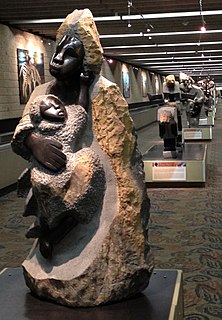
Harare is the capital and most populous city of Zimbabwe. The city proper has an area of 960.6 km2 (371 mi2) and a population 2,123,132 in the 2012 census and an estimated 3,120,917 in its metropolitan area in 2019. Situated in north-eastern Zimbabwe in the country's Mashonaland region, Harare is a metropolitan province, which also incorporates the municipalities of Chitungwiza and Epworth. The city sits on a plateau at an elevation of 1,483 metres above sea level and its climate falls into the subtropical highland category.

The stone-carved Zimbabwe Bird is the national emblem of Zimbabwe, appearing on the national flags and coats of arms of both Zimbabwe and Rhodesia, as well as on banknotes and coins. It probably represents the bateleur eagle or the African fish eagle. The bird's design is derived from a number of soapstone sculptures found in the ruins of the medieval city of Great Zimbabwe.

The Chapungu Sculpture Park is a sculpture park in Msasa, Harare, Zimbabwe, which displays the work of Zimbabwean stone sculptors. It was founded in 1970 by Roy Guthrie, who was instrumental in promoting the work of its sculptors worldwide. One way this was done was by exhibiting the sculptures in Botanical Gardens in a touring exhibition called "Chapungu: Custom and Legend — A Culture in Stone". The places visited include:

Tapfuma Gutsa is a Zimbabwean sculptor.
Nicholas Mukomberanwa was a Zimbabwean sculptor and art teacher. He was among the most famous products of the Workshop School at the National Gallery of Zimbabwe and an art mentor and teacher to the Mukomberanwa Family of sculptors. His work has been exhibited in galleries around the world and he remains one of Zimbabwe's most famous artists.
Bernard Matemera was a Zimbabwean sculptor. The sculptural movement of which he was part is usually referred to as "Shona sculpture", although some of its recognised members are not ethnically Shona. His whole professional career was spent at the Tengenenge Sculpture Community, 150 km north of Harare near Guruve.

Joram Mariga has been called the “Father of Zimbabwean Sculpture” because of his influence on the local artistic community starting in the 1950s and continuing until his death in 2000. The sculptural movement of which he was part is usually referred to as “Shona sculpture”, although some of its recognised members are not ethnically Shona.
John Takawira was a Zimbabwean sculptor. The background to the sculptural movement of which he was a leading member is given in the article on Shona art.

Henry Munyaradzi was a Zimbabwean sculptor. The sculptural movement of which he was part is usually referred to as "Shona sculpture", although some of its recognised members are not ethnically Shona. He worked initially at the Tengenenge Sculpture Community, 150 km north of Harare near Guruve, which he joined in 1967. In that Community, and ultimately in the wider world of lovers of Zimbabwean art, he was known simply as 'Henry'.
Square Chikwanda is a Zimbabwean sculptor, living and working in Harare, Zimbabwe. He first learned his art from his father, also a Zimbabwean sculptor.
Brian Watyoka is a Zimbabwean sculptor.
Fanizani Akuda, also known as Fanizani Phiri, was a member of the sculptural movement usually called "Shona sculpture", although he and some others of its recognised members were not ethnically Shona. He worked initially at the Tengenenge Sculpture Community, 150 km north of Harare near Guruve, which he joined in 1966.

Agnes Nyanhongo is a Zimbabwean stone sculptor.
Zimbabwean art includes decorative esthetics applied to many aspects of life, including art objects as such, utilitarian objects, objects used in religion, warfare, in propaganda, and in many other spheres. Within this broad arena, Zimbabwe has several identifiable categories of art. It is a hallmark of African cultures in general that art touches many aspects of life, and most tribes have a vigorous and often recognisable canon of styles and a great range of art-worked objects. These can include masks, drums, textile decoration, beadwork, carving, sculpture, ceramic in various forms, housing and the person themselves. Decoration of the body in permanent ways such as scarification or tattoo or impermanently as in painting the body for a ceremony is a common feature of African cultures.

Sculpture and in particular stone sculpture is an art for which Zimbabwe is well known around the world.
Celia Winter-Irving, was an Australian-born, Zimbabwean-based artist and art critic who wrote extensively on Zimbabwean art, especially Shona sculpture, when she lived in Harare from 1987 to 2008.
The following is a timeline of the history of the city of Harare, Zimbabwe.
Doreen Sibanda is a UK-born Zimbabwean artist, curator and arts administrator. She has been the Executive Director of the National Gallery of Zimbabwe since 2004.

Tengenenge is a community of artists and their families located in the Guruve District of Zimbabwe. It has achieved international recognition because of the large number of sculptors who have lived and worked there since 1966. These include Fanizani Akuda, Bernard Matemera, Sylvester Mubayi, Henry Munyaradzi and Bernard Takawira.
Greenwood Park is both a city park and a small urban neighbourhood located in the northeast section of Harare's central business district and is one of the early subdivisions which were created inside Harare, but which lay outside of the original, officially-planned City of Salisbury. Situated two kilometres north of Parliament, Greenwood Park overlaps with the larger and newer neighbourhood of Avenues and is usually considered to be a part of that more prominent locale. The area of Greenwood Park, and is best known for its eponymous park which covers much of the area.








